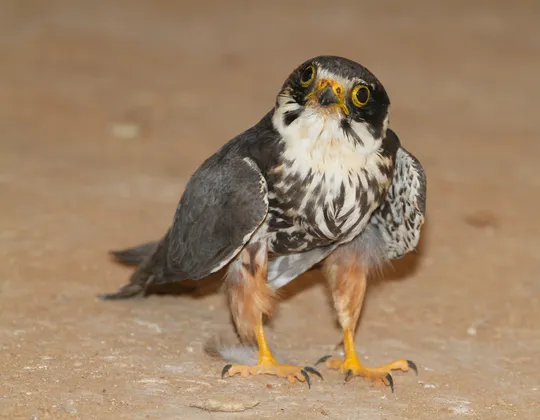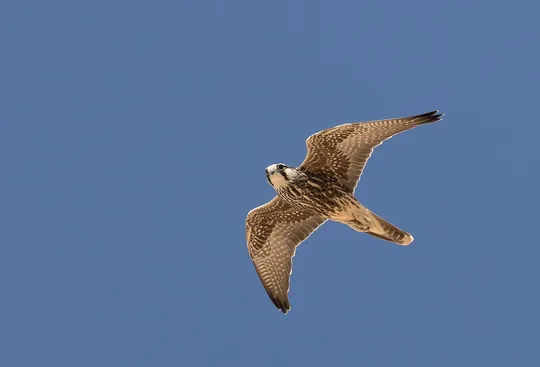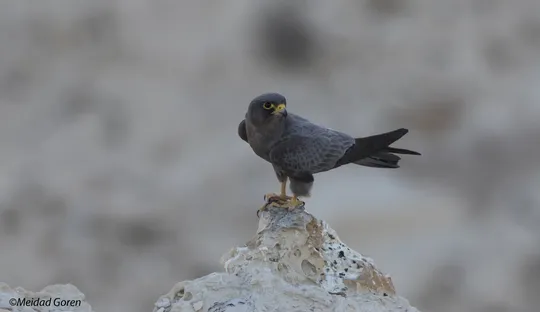Falco pelegrinoides
 Endangered
Endangered
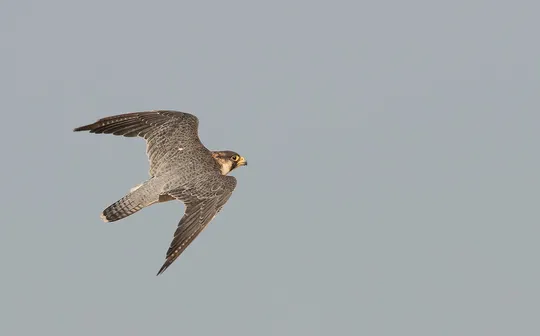
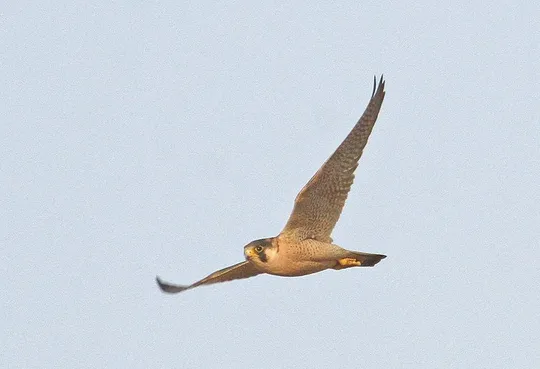
| Habitats | Desert Cliffs |
|---|---|
| Presence In Israel | Resident |
| Breeding In Israel | Breeder |
| Migration Types | Resident |
| Zoographical Zones | Saharo-Arabian, Sudani |
| Landscape Types | Cliffs |
| Vegetation Densities | Low |
| Nest Locations | Cliffs |
| Diet Types | Terrestrial Vertebrates |
| Foraging Grounds | Aerial |
| Body Sizes | Medium (500 - 1000g) |
| Threat Factors | Human Settlements in Gorges, Hikers and rock climbers, Hunting and trapping |
The Barbary Falcon is a medium- to large-sized falcon, the smallest in the “large falcons” group. Treated here as a separate species, although by some specialists (including Birdlife International) considered a subspecies of the Peregrine Falcon. Its back and upperparts are bluish-grey, and it has a brown crown and reddish nape, a sandy colored belly and breast, with delicate spotting. It feeds mostly on birds it catches in flight, including swifts and swallows, but also pigeons, sandgrouse, sand partridges, larks and others.
The Barbary Falcon is a resident breeding species in the desert region: the Judean Desert (north up to Nahal Kidron area), the Negev Highlands, the Eastern Negev, the Arava and the Eilat Mountains. In winter, it can also be seen in the Western Negev, in Jerusalem and in the Tel-Aviv Metropolitan area. Approximately 100 pairs nested in Israel in the 1980s, when its range was more extensive, including in eastern Samaria and the western Negev Highlands (Shirihai 1996). During the last decade Barbary Falcons have not been observed breeding in Eastern Samaria, in the western Negev Highlands, nor in the northern and western parts of the Judean Desert (most of the pairs in the Judean Desert are now concentrated along the Fault Escarpment). The current population is estimated at 50 to 60 pairs.
In Eastern Samaria and in western parts of the Judean Desert, the Barbary Falcon was adversely affected by human presence, such as grazing on cliffs, and settlement of herders and their herds in caves and in the steep wadis. It is not clear why it receded in the western Negev Highlands. It was probably also adversely affected by trapping and collection for falconry, with juveniles that wander outside Israel’s borders being the main victims, but there is very little information regarding this.
No specific conservation measures have been taken for this species to date.
The Barbary Falcon is classified as endangered (EN); its population is very small and restricted to relatively undisturbed cliffs in the Judean Desert and the Eastern Negev. During the past two decades, the population has receded from the northern and western parts of its range. A study to investigate the threat factors endangering the species should be conducted and a conservation program be formulated based on the results.
The dispersal and land-use patterns of Barbary falcons, as well as the factors threatening them, are not sufficiently understood. A study should be conducted to gather information on these topics.
The Barbary Falcon breeds from mid-February to July, in cliff alcoves, usually in canyons and on the Fault Escarpment along the Judean Desert. It lays 2-5 eggs, usually in an unlined nest, and occasionally in abandoned nests of crows or other raptors. Incubation lasts 28-30 days and the young fledge from the nest at the age of 33-39 days.
- הצופה, א. ומירוז, א. 2015. תכנית אב לשימור העופות הדורסים בישראל. מסמך פנימי של רשות הטבע והגנים.
- הרלינג, א. 2001. סיכום סקר קינון דורסי יום בשמורת עין גדי. דו"ח רשות הטבע והגנים.
- מירוז, א. והצופה, א. 2014. סיכום סקר קינון עופות דורסים במדבר יהודה. דו"ח רשות הטבע והגנים.
- פז, ע. 1986. עופות. מתוך אלון, ע. (עורך), החי והצומח של ארץ ישראל. כרך 6. הוצאת משרד הביטחון, ישראל.
- פרומקין, ר., מן ש., 1984 .קנון דורסים בחבל המדברי של ישראל 1984-1980. העזניה גליון 11. הוצאת החברה להגנת הטבע.
- פרלמן, י., אלתרמן, ש. וגרניט, ב. 2011. סקר עופות דוגרים בנחלים הפנימיים, אביב 2011. דו"ח מרכז הצפרות של החברה להגנת הטבע.
- פרלמן, י., שוחט, א. ולבינגר, ז. 2009. סקר אטלס ציפורים בערבה סיכום שנת 2009. דו"ח מרכז הצפרות של החברה להגנת הטבע.
- Shirihai, H., 1996. The Birds of Israel. Academic Press, London.
- Symes, A. 2013. Species generation lengths. Unpublished, BirdLife International.
- Species page at Birdlife International
Current Occupancy Map
| Data Missing | Sporadic | Limited Sites | Low Density | High Density |
|---|---|---|---|---|
| 0 | 0 | 0 | 0 | 0 |
Distribution maps
The maps presented here provide visual information on the distribution of species in Israel from the past and present, and the changes in occupancy and breeding density during the comparison period. For further reading
Relative Abundance 2010-2020
Breeding density values in the current decade as determined from experts' opinion and observations from databases.
| Data Missing | Sporadic | Limited Sites | Low Density | High Density |
|---|---|---|---|---|
| 8 | 12 | 12 | 21 | 19 |
Relative Abundance 1980-1990
Density values based primarily on the book The Birds of Israel (Shirihai 1996).
| Data Missing | Sporadic | Limited Sites | Low Density | High Density |
|---|---|---|---|---|
| 5 | 14 | 14 | 17 | 22 |
Occupancy 1990-2020
The map shows differences in the species breeding distribution between the 1980's breeding map and the current weighted breeding evaluation. Negative value - species previously bred in the grid and is not presently breeding; positive value - species has not previously bred in the grid and is currently breeding.
| Data Missing | No Change | Occupancy Increase | Occupancy Decrease |
|---|---|---|---|
| 6 | 35 | 1 | 9 |
Change in Relative Abundance 1990-2020
The map shows the changes in the relative abundance of a species in each of the distribution grids between the breeding map of the 1980s and the weighted current breeding evaluation. Negative values - decline in abundance; positive values - increase in abundance; zero - no change in abundance.
| 80 to 100 | 50 | 20 to 30 | No Change | 30- to 20- | 50- | 100- to 80- | Data Missing |
|---|---|---|---|---|---|---|---|
| 0 | 4 | 2 | 22 | 12 | 14 | 11 | 16 |
| Rarity | |
|---|---|
| Vulnerability | |
| Attractiveness | |
| Endemism | |
| Red number | |
| Peripherality | |
| IUCN category | |
| Threat Definition according to the red book |
 Contributed:
Contributed: 